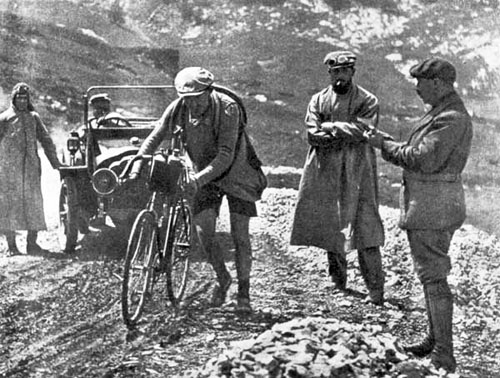Tour de France
by Rob Zaretsky
Today, we work at cycling. The Honors College at the University of Houston presents this series about the machines that make our civilization run, and the people whose ingenuity created them.
The Tour de France wobbled into the world in 1903, the offspring of the mass-produced bicycle and mass-produced news. Not surprisingly, it was often difficult to distinguish between cycle and cyclist. Where did the machine leave off and man begin?
By the end of 19th century, factories were churning out bicycles. As their price dropped, two-wheelers filled the streets of Europe. The impact was revolutionary: workers now had the same mobility and freedom as their social "betters".
The impact of mass circulation papers was equally revolutionary. Not just general newspapers, but papers that catered to another mass activity: sports. In 1902, a French newspaper devoted to racing hatched a stunning public relations scheme: a bicycle race across the width and breadth of France.
 The first Tour de France took place the following year. It stretched over more than two weeks and nearly 2,400 kilometers. But this epic event was a mere rehearsal for future races; during the interwar years, the Tour exceeded 5,000 kilometers and lasted more than three weeks.
The first Tour de France took place the following year. It stretched over more than two weeks and nearly 2,400 kilometers. But this epic event was a mere rehearsal for future races; during the interwar years, the Tour exceeded 5,000 kilometers and lasted more than three weeks.
The press relished the race's extreme demands and suffering of its contestants. Journalists outdid one another in their descriptions of the cyclists' "ravaged" and "gaunt" faces. Cyclists who gave up or simply collapsed on the side of the road were "fallen comrades." These phrases meant much in a nation that lost more than one million men in WW-I. The race's founder, Henri Desgranges, declared the ideal Tour "would be one in which there was only one finisher."
The cyclists, in essence, became machines. They were extensions not just of their bicycles, but also the factories where many of them had once worked. The Tour promised not just fame, but money. The finish line marked the divide between working class woes and middle class comfort.
Ironically, this path to bourgeois freedom seemed industrial. The race was almost factory like. It required stamina, not skill. Have legs, will travel: especially legs that pumped like pistons. Cyclists were known as "pedal workers", even "convict labor of the road."
The Tour organizers long denied the cyclists the right to unionize. More astonishingly, the organizers also resisted the introduction of gears. They thought such technology would cheapen the cyclist's achievement. It would make cycling easier -- another way of saying it would lessen the pain.
But fans who'd long used gears on their cycles, disagreed. What they wanted were cyclists who could go faster and further. And so gears were finally allowed, along with improvements in clothing and logistics. A much more insidious technological advance -- drugs -- though not permitted, was long winked at. From opiates and cocaine, cyclists graduated to amphetamines and steroids. By seeing the cyclists as human machines, we consider drugs little more than lubricants. But what if we were asked to see cyclists as human beings -- people asked to do more than is humanly possible?
I'm Rob Zaretsky, at the University of Houston, where we're interested in the way inventive minds work.
C. S. Thompson, The Tour de France. (Berkeley, CA: University of California Press).
For more on the Tour de France, see Episode 2262. Images courtesy of Wikipedia.

Henri Desgrange (center with bicycle) competing in an early bicycle race.